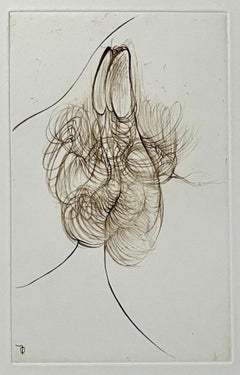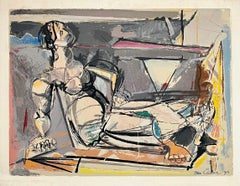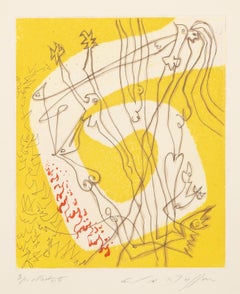Mail Nude Prints
to
2
Overall Width
to
Overall Height
to
2
2
2
2
969
1,946
1,202
895
766
508
463
389
366
278
102
96
75
66
53
47
47
45
39
39
2
2
2
2
Art Subject: Mail
Pablo Picasso ( 1881 – 1973 ) – hand-signed etching on BFK Rives paper – 1968
Located in Varese, IT
etching on BFK Rives paper, Edited in 1968
Limited edition of 50 copies
Current copy numbered: 8/50 on the lower left corner
signed in pencil by artist in lower right corner
Plate si...
Category
1960s Cubist Nude Prints
Materials
Paper, Etching
Pablo Picasso ( 1881 – 1973 ) – hand-signed etching on wove paper – 1968
Located in Varese, IT
Grosse Prostituée, Sorcière à la Chouette et Voyageur en Sabots ( Ref: Bloch 1760)
etching on wove paper, Edited in 1968
Limited edition of 50 copies
Current copy numbered: 37/50 on...
Category
1960s Cubist Nude Prints
Materials
Paper, Etching
Related Items
German Surrealist Hans Bellmer Etching Engraving Print Cecile Reims Surrealism
By Hans Bellmer
Located in Surfside, FL
After Hans Bellmer (German, 1902-1975)
Surrealist engraving, etching
after drawings from a 1942 notebook,
engraved in 1974-75 by Cecile Reims
Printed by L'Atelier de Chalcographie du Louvre, Paris,
Having printed monogram lower left in plate, pencil notations and #7/10 and 'Musee du Louvre' blindstamp verso
Dimensions: Sheet 11 X 7.5, Plate size 6.5 X 4
Hans Bellmer ( 1902 – 1975) was a Polish born German artist, best known for his drawings, etchings that illustrates the 1940 edition of Histoire de l’œil, and the life-sized female sculpture mannequin dolls he produced in the mid-1930s. Historians of art and photography also consider him a Surrealist photographer.
Bellmer was born in the city of Kattowitz, then part of the German Empire (now Katowice, Poland). Up until 1926, he worked as a draftsman for his own advertising company.
Bellmer is most famous for the creation of a series of dolls as well as photographs of them. He was influenced in his choice of art form in part by reading the published letters of Oskar Kokoschka (Der Fetisch, 1925) and Surrealism. Bellmer's puppet doll project is also said to have been catalysed by a series of events in his personal life.
Hans Bellmer takes credit for provoking a physical crisis in his father and brings his own artistic creativity into association with childhood insubordination and resentment toward a severe and humorless paternal authority. Perhaps this is one reason for the nearly universal, unquestioning acceptance in the literature of Bellmer's promotion of his art as a struggle against his father, the police, and ultimately, fascism and the state. Events of his personal life also including meeting a beautiful teenage cousin in 1932 (and perhaps other unattainable beauties), attending a performance of Jacques Offenbach's Tales of Hoffmann (in which a man falls tragically in love with an automaton), and receiving a box of his old toys. After these events, he began to actually construct his first dolls. In his works, Bellmer explicitly sexualized the doll as a young girl (his work bears connection to the works of Bathus). Hirschfeld has claimed (without further argumentation) that Bellmer initiated his doll project to oppose the fascism of the Nazi Party by declaring that he would make no work that would support the new German state. Represented by mutated forms and unconventional poses, his dolls (according to this view) were directed specifically at the cult of the perfect body then prominent in Germany.
He visited Paris in 1935 and made contacts there, such as Paul Éluard, but returned to Berlin because his wife Margarete was dying of tuberculosis. He was part of the circle of Surrealist luminaries such as Man Ray, Marcel Duchamp, Max Ernst, Joan Miro, André Masson, René Magritte, Alberto Giacometti and Salvador Dali as well as women artists—such as Frida Kahlo, Dorothea Tanning and Leonora Carrington.
Bellmer produced the first doll in Berlin in 1933. Long since lost, the assemblage can nevertheless be correctly described thanks to approximately two dozen photographs Bellmer took at the time of its construction. Standing about fifty-six inches tall, the doll consisted of a modeled torso made of flax fiber, glue, and plaster; a mask-like head of the same material with glass eyes and a long, unkempt wig; and a pair of legs made from broomsticks or dowel rods. One of these legs terminated in a wooden, club-like foot; the other was encased in a more naturalistic plaster shell, jointed at the knee and ankle. As the project progressed, Bellmer made a second set of hollow plaster legs, with wooden ball joints for the doll's hips and knees. There were no arms to the first sculpture, but Bellmer did fashion or find a single wooden hand, which appears among the assortment of doll parts the artist documented in an untitled photograph of 1934, as well as in several photographs of later work.
Bellmer's 1934 anonymous book, The Doll (Die Puppe), produced and published privately in Germany, contains 10 black-and-white photographs of Bellmer's first doll arranged in a series of "tableaux vivants" (living pictures). The book was not credited to him, as he worked in isolation, and his photographs remained almost unknown in Germany. Yet Bellmer's work was eventually declared "degenerate" (entartete kunst) by the Nazi Party, and he was forced to flee Germany to France in 1938, where Bellmer's work was welcomed by the Surrealists around Andre Breton.
He aided the French Resistance during the war by making fake passports. He was imprisoned in the Camp des Milles prison at Aix-en-Provence, a brickworks camp for German nationals, from September 1939 until the end of the Phoney War in May 1940.
After the war, Bellmer lived the rest of his life in Paris. Bellmer gave up doll-making and spent the following decades creating erotic drawings, etchings, sexually explicit photographs, paintings, and prints of pubescent girls. In 1954, he met Unica Zürn...
Category
20th Century Abstract Prints
Materials
Etching
American Modernist Cubist Lithograph Screenprint "Reclining Woman" Max Weber
By Max Weber
Located in Surfside, FL
Reclining Cubist Nude Woman
Max Weber (April 18, 1881 – October 4, 1961) was a Jewish-American painter and one of the first American Cubist painters who, in later life, turned to more figurative Jewish themes in his art. He is best known today for Chinese Restaurant (1915), in the collection of the Whitney Museum of American Art, "the finest canvas of his Cubist phase," in the words of art historian Avis Berman.
Born in the Polish city of Białystok, then part of the Russian Empire, Weber emigrated to the United States and settled in Brooklyn with his Orthodox Jewish parents at the age of ten. He studied art at the Pratt Institute in Brooklyn under Arthur Wesley Dow. Dow was a fortunate early influence on Weber as he was an "enlightened and vital teacher" in a time of conservative art instruction, a man who was interested in new approaches to creating art. Dow had met Paul Gauguin in Pont-Aven, was a devoted student of Japanese art, and defended the advanced modernist painting and sculpture he saw at the Armory Show in New York in 1913.
In 1905, after teaching in Virginia and Minnesota, Weber had saved enough money to travel to Europe, where he studied at the Académie Julian in Paris and acquainted himself with the work of such modernists as Henri Rousseau (who became a good friend), Henri Matisse, Pablo Picasso, and other members of the School of Paris. His friends among fellow Americans included some equally adventurous young painters, such as Abraham Walkowitz, H. Lyman Sayen, and Patrick Henry Bruce. Avant-garde France in the years immediately before World War I was fertile and welcoming territory for Weber, then in his early twenties. He arrived in Paris in time to see a major Cézanne exhibition, meet the poet Guillaume Apollinaire, frequent Gertrude Stein's salon, and enroll in classes in Matisse's private "Academie." Rousseau gave him some of his works; others, Weber purchased. He was responsible for Rousseau's first exhibition in the United States.
In 1909 he returned to New York and helped to introduce Cubism to America. He is now considered one of the most significant early American Cubists, but the reception his work received in New York at the time was profoundly discouraging. Critical response to his paintings in a 1911 show at the 291 gallery, run by Alfred Stieglitz, was an occasion for "one of the most merciless critical whippings that any artist has received in America." The reviews were "of an almost hysterical violence." He was attacked for his "brutal, vulgar, and unnecessary art license." Even a critic who usually tried to be sympathetic to new art, James Gibbons Huneker, protested that the artist's clever technique had left viewers with no real picture and made use of the adage, "The operation was successful, but the patient died."[8] As art historian Sam Hunter wrote, "Weber's wistful, tentative Cubism provided the philistine press with their first solid target prior to the Armory Show."
The Cellist...
Category
Mid-20th Century Cubist Abstract Prints
Materials
Screen
Picasso, Sculpteur au Repos avec Modèle démasqué et sa Représentation (after)
Located in Fairfield, CT
Artist: After Pablo Picasso (1881-1973)
Title: Sculpteur au Repos avec Modèle démasqué et sa Représentation sculptée (after Bloch 159)
Year: 1992
Medium: Reproduced from the original...
Category
1990s Cubist Nude Prints
Materials
Lithograph
347 SERIES (BLOCH 1502)
Located in Aventura, FL
Etching on paper. Hand signed and numbered by the artist. From the 347 series. Bloch 1502. Edition of 50. Sheet size: 18 x 22 inches. Image size 12.375 ...
Category
1960s Cubist Figurative Prints
Materials
Paper, Etching
Picasso, Minotaure blesse VI (after)
Located in Fairfield, CT
Artist: After Pablo Picasso (1881-1973)
Title: Minotaure blesse VI (Bloch 196)
Year: 1992
Medium: Reproduced from the original edition using the grain Autotype halftone screen process by Druck- und Verlag GmbH, 4200 Oberhausen, Germany; lithographically printed by Druck- und Verlag GmbH on japon handmade 200 g/sqm paper by created by Richard de Bas in Ambert, France and imported by Japico Drissler Feinpapiere, Frankfurt, Germany.
Paper Size: 18 x 12.75 inches; a size slightly reduced from the original Vollard edition for differentiation
Condition: Excellent
Inscription: Artist’s signature posthumously lithographically reproduced from the original Vollard edition, and numbered in pencil by the curators of the Municipal Museum Mülheim an der Ruhr, Germany. 168/300.
Notes: Published by Municipal Museum Mülheim an der Ruhr, Germany in cooperation with the Society for the Promotion of the museum in 1992 and the Fundación Picasso; printed by Plitt Druck- und Verlag GmbH, 4200 Oberhausen, Germany. The following is a German to English translation of the original text issued by the Municipal Museum Mülheim an der Ruhr, Germany in the following from which this graphic is a part, “In order to give a broad public access to this unique print work by Pablo Picasso in its entirety and at the highest quality level, the support group for the city. Museum Mülheim an der Ruhr initiated and significantly supported the new edition of the “Suite Vollard.” The reprint of the "Suite Vollard" includes a limited edition of 300 copies of 100 loose sheets each in a linen cassette. The copies were numbered from 1 to 300 on the leader sheet. The reproductions were produced in grain screen mode, a process in which which eliminates the traditional line grid and achieves maximum originality. The paper was hand-made specifically for this work by Richard de Bas in Ambert, France, one of the most traditional paper mills in Europe. The paper for the original edition also comes from this factory. The quality Blane narcisse, belin, 200 g/sqm was selected and imported from Japico Drissler Feinpapiere, Frankfurt. Reproduction and paper format has been slightly reduced compared to the original edition. The technical development and overall production was carried out by Plitt Druck- und Verlag GmbH, 4200 Oberhausen.”
PABLO PICASSO (1881-1973) Spanish painter and sculptor is one of the most recognized figures of twentieth century art. During his artistic career, which lasted more than 75 years, he created thousands of works using all kinds of mediums. He changed art more profoundly than any other artist of his time. First famous for pioneering cubism...
Category
1990s Cubist Nude Prints
Materials
Lithograph
Picasso, Minotaure, Buveur et Femmes (after)
Located in Fairfield, CT
Minotaure aveugle guidé par une Fillette dans la Nuit (after Bloch 225)
PABLO PICASSO (1881-1973) Spanish painter and sculptor is one of the most recognized figures of twentieth cen...
Category
1990s Cubist Nude Prints
Materials
Lithograph
QUATRE NUS AU HAREM
Located in Aventura, FL
Selected from the personal collection inherited by Marina Picasso, Pablo Picasso's granddaughter. After Pablo Picasso's death, his granddaughter Marina authorized the printing of t...
Category
1980s Cubist Nude Prints
Materials
Paper, Lithograph
Deux Femmes Accroupies - Lithograph by Pablo Picasso - 1956
Located in Roma, IT
Realized by Picasso in 1956. Lithograph on Arches Paper.
Hand Signed and numbered.
Edition of 19/50.
Ref. Bloch n.790.
Category
1950s Cubist Figurative Prints
Materials
Paper, Lithograph
H 19.69 in W 25.6 in D 0.04 in
Picasso, Minotaure Caressant Une Femme (after)
Located in Fairfield, CT
Artist: After Pablo Picasso (1881-1973)
Title: Minotaure Caressant Une Femme (after Bloch 191)
Year: 1992
Medium: Reproduced from the ori...
Category
1990s Cubist Nude Prints
Materials
Lithograph
Picasso, Le Repos du Sculpteur devant un Nu à la Draperie (after)
Located in Fairfield, CT
Artist: After Pablo Picasso (1881-1973)
Title: Le Repos du Sculpteur devant un Nu à la Draperie (after Bloch 160)
Year: 1992
Medium: Reproduced from the original edition using the gr...
Category
1990s Cubist Nude Prints
Materials
Lithograph
Picasso, Minotaure aveugle guidé dans la Nuit par une Petite (after)
Located in Fairfield, CT
Artist: After Pablo Picasso (1881-1973)
Title: Minotaure aveugle guidé dans la Nuit par une Petite Fille au Pigeon (after Bloch 223)
Year: 1992
Medium: Reproduced from the original e...
Category
1990s Cubist Nude Prints
Materials
Lithograph
MOUSQUETAIRE ET ODALISQUE, MEDUSE, PLATE 47 FROM SERIES 156 (BLOCH 1902)
Located in Aventura, FL
Mousquetaire et Odalisque, méduse, plate 47 from Series 156. Bloch 1902; Baer 1908. Etching on wove paper. Stamped signature, hand numbered in pencil. Edition of 50. Published by G...
Category
1970s Cubist Nude Prints
Materials
Paper, Etching
H 16.25 in W 18.875 in D 1 in
Previously Available Items
Femme et oiseau, Surrealist Etching by Andre Masson
By André Masson
Located in Long Island City, NY
Andre Masson, French (1896 - 1987) - Femme et oiseau, Medium: Etching and aquatint, signed and numbered in pencil, Image Size: 8 x 6.75 inches, Size: 16.75 x 12.5 in. (42.55 x 31.75...
Category
1940s Surrealist Nude Prints
Materials
Etching, Aquatint


